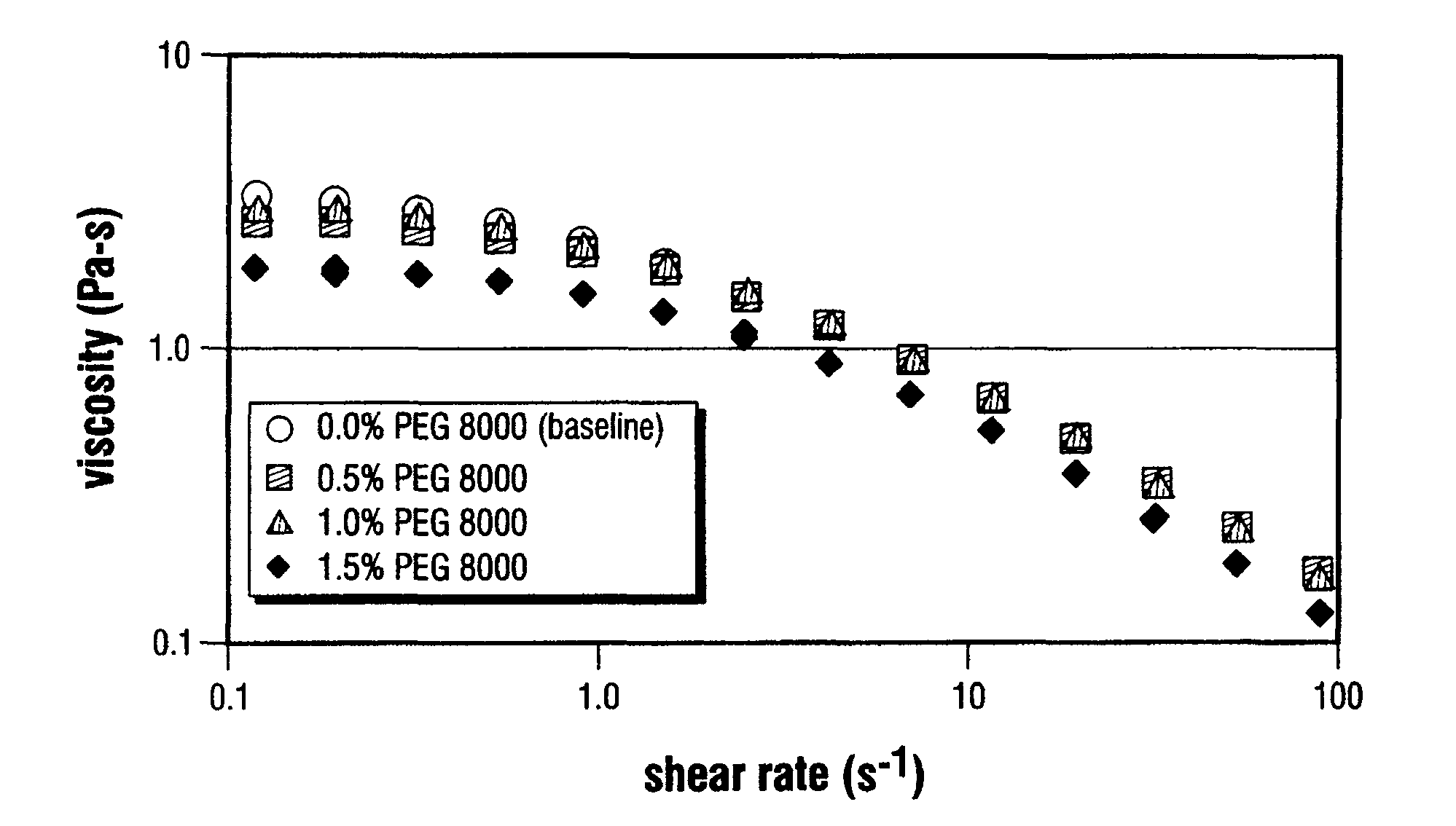Stabilizing biphasic concentrates through the addition of small amounts of high molecular weight polyelectrolytes
a polyelectrolyte, small amount technology, applied in the direction of fluid removal, chemistry apparatus and processes, borehole/well accessories, etc., can solve the problems of affecting the hydration ability affecting the hydration efficiency of small guar particles, and not meeting the rule of thumb
- Summary
- Abstract
- Description
- Claims
- Application Information
AI Technical Summary
Benefits of technology
Problems solved by technology
Method used
Image
Examples
example 1
[0087]FIG. 1 illustrates an approximated binodal curve for the aqueous systems of guar and polyethylene glycol having a molecular weight of 8000 (PEG 8000) in deionized (DI) water, wherein filled circles indicate single-phase mixtures and open circles indicate biphasic mixtures comprising low-viscosity guar concentrates, and wherein the diagonal line represents an embodiment of a dilution path for making a 0.5 wt % guar solution from a 1:1 guar:PEG 8000 concentrate.
[0088]A low viscosity aqueous suspension of guar with PEG 8000. A series of polymer solutions was created by dissolving 0-4 weight percent dry guar and 0-4 weight percent dry polyethylene glycol (PEG 8000) in deionized (DI) water. In each case, 200 ml of DI water were used, and the polymers were measured as dry powders with percentages expressed on a total fluid weight basis. For each sample, the dry polymers were mixed together and then added together into the DI water while stirring vigorously in a WARING blender. Each ...
example 2
[0092]FIG. 2 illustrates a phase diagram for guar mixed with PEG 8000 in DI water including the binodal separating single-phase solutions from two-phase solutions; the equivolumetric biphase line indicating compositions where equilibrium phase separation results in two phases of equal volume, and wherein compositions above and below the equivolumetric biphase line form relatively larger and smaller concentrated guar phases; and one embodiment according to the invention of a limit line where the mixture can be diluted to 0.5 wt % guar without rheological changes due to the PEG 8000, corresponding to a weight ratio of guar:PEG 8000 of approximately 5:8.
[0093]Wellsite guar delivery system using low viscosity aqueous suspension. FIG. 2 provides a phase diagram for a high molecular weight guar routinely used for wellbore treatment fluids. As in the phase diagram of FIG. 1, the guar in this example was again phase separated with PEG 8000. Line 20 on the phase diagram indicates the binodal...
example 3
[0096]FIG. 3 shows the rheology of 0.5 wt % guar solutions with and without addition of PEG 8000, in terms of apparent viscosity versus shear rate, indicating that concentrations of PEG 8000 less than approximately 1 wt % do not measurably alter the rheology of 0.5 wt % guar solutions according to one embodiment of the invention.
[0097]Effect of diluted PEG 8000 on viscosity of linear gels. FIG. 3 shows the rheology of 0.5 wt % guar solutions with and without addition of PEG 8000, in terms of apparent viscosity versus shear rate. Concentrations of PEG 8000 less than approximately 1 wt % do not measurably alter the rheology of 0.5 wt % guar solutions. Specifically, the data shown in FIG. 3 illustrate that addition of PEG 8000 to a 0.5% guar solution (40 lbs / 1000 gallons) has negligible impact on the guar solution rheology for PEG 8000 concentrations up to at least 1 wt %. This is a critical, unexpected result, that a phase-separated, low viscosity concentrate can be used to deliver gu...
PUM
| Property | Measurement | Unit |
|---|---|---|
| weight percent | aaaaa | aaaaa |
| temperature | aaaaa | aaaaa |
| volume percent | aaaaa | aaaaa |
Abstract
Description
Claims
Application Information
 Login to View More
Login to View More - R&D
- Intellectual Property
- Life Sciences
- Materials
- Tech Scout
- Unparalleled Data Quality
- Higher Quality Content
- 60% Fewer Hallucinations
Browse by: Latest US Patents, China's latest patents, Technical Efficacy Thesaurus, Application Domain, Technology Topic, Popular Technical Reports.
© 2025 PatSnap. All rights reserved.Legal|Privacy policy|Modern Slavery Act Transparency Statement|Sitemap|About US| Contact US: help@patsnap.com



